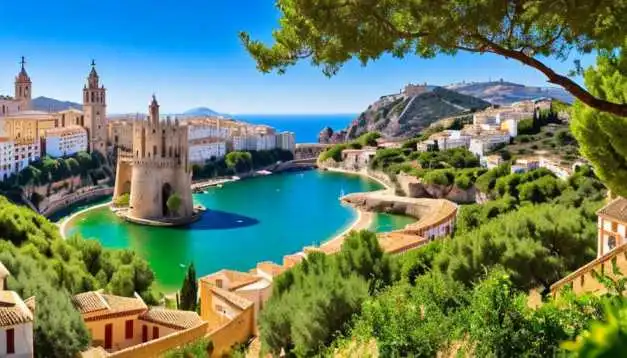Follow the trend

Spain, a country known for its vibrant culture, rich history, and stunning landscapes, offers an enticing blend of old-world charm and modern delights. In this comprehensive travel guide, we will delve into the captivating history of Spain, reveal the top 10 must-visit places, provide insights into the best time to explore this diverse country, guide you through the visa process, highlight the currency used, and offer valuable information about the weather. Join us as we embark on an unforgettable journey through the wonders of Spain.
Spain's history is a tapestry woven with the influences of various civilizations, including the Romans, Moors, and Visigoths. From the architectural wonders of Alhambra in Granada to the medieval city walls of Toledo, Spain showcases a rich cultural heritage that spans centuries. Visit the ancient Roman theater in Mérida, marvel at the preserved Roman aqueduct in Segovia, and explore the historic Jewish Quarter in Cordoba.
a. Barcelona: Barcelona, the vibrant capital of Catalonia, offers a mix of stunning architecture, cultural attractions, and a lively atmosphere. Explore the architectural wonders of Antoni Gaudí, including the famous Sagrada Família and Park Güell. Stroll along the vibrant pedestrian street of La Rambla, visit the Gothic Quarter, and indulge in delicious Catalan cuisine.
b. Madrid: As the capital and cultural hub of Spain, Madrid is a city brimming with art, history, and energy. Discover the artistic treasures of the Prado Museum, which houses masterpieces by Goya, Velázquez, and El Greco. Wander through the elegant Retiro Park, home to beautiful gardens, sculptures, and a serene lake. Experience the vibrant nightlife in the bustling city center, where lively bars and clubs await.
c. Seville: Seville, the capital of Andalusia, enchants visitors with its rich history, stunning architecture, and passionate flamenco performances. Immerse yourself in the breathtaking Moorish architecture of the Alcázar, a royal palace that showcases intricate tilework and lush gardens. Marvel at the grandeur of the Seville Cathedral and Giralda Tower, the largest Gothic cathedral in the world.
d. Granada: Granada, nestled at the foot of the Sierra Nevada mountains, is famous for its crowning jewel, the Alhambra. Explore the magnificent palace complex, adorned with intricate Islamic architecture, stunning courtyards, and breathtaking views of the city. Wander through the narrow streets of the Albayzín neighborhood, a UNESCO World Heritage site, and soak in the vibrant atmosphere.
e. Valencia: Valencia, on the eastern coast of Spain, offers a blend of history, modern architecture, and coastal beauty. Explore the futuristic City of Arts and Sciences, a complex that houses a planetarium, opera house, and interactive science museum. Relax on the sandy beaches and enjoy the sparkling Mediterranean Sea. Don't forget to savor the world-famous Valencian paella, a culinary delight.
f. Cordoba: Cordoba, located in the Andalusia region, was once the capital of the Islamic Caliphate. Visit the mesmerizing Mezquita, a former mosque turned cathedral, known for its iconic horseshoe arches and stunning interior. Wander through the narrow streets of the Jewish Quarter, filled with whitewashed houses adorned with colorful flowers.
g. San Sebastian: San Sebastian, situated in the Basque Country, captivates visitors with its beautiful beaches, culinary delights, and elegant Belle Époque architecture. Indulge in the city's culinary scene by sampling pintxos, Basque-style tapas, in the charming Old Town. Relax on the stunning La Concha Beach, considered one of the most beautiful urban beaches in Europe.
h. Toledo: Toledo, a UNESCO World Heritage city, is a treasure trove of history and culture. Marvel at the well-preserved medieval city walls, wander through the narrow streets filled with architectural gems, and visit the stunning Toledo Cathedral, a masterpiece of Gothic and Renaissance architecture. Explore the city's Jewish, Christian, and Islamic heritage, evident in its synagogues, churches, and mosques.
i. Mallorca: Mallorca, the largest Balearic Island, entices visitors with its beautiful beaches, charming villages, and dramatic landscapes. Relax on the picturesque sandy beaches, explore the quaint villages nestled in the Serra de Tramuntana mountains, and visit the historic Palma Cathedral, a stunning example of Gothic architecture.
j. Canary Islands: The Canary Islands, a Spanish archipelago off the northwest coast of Africa, offer a paradise of diverse landscapes and year-round mild climate. Enjoy the sun and relax on the beautiful beaches of Tenerife, Gran Canaria, or Lanzarote. Explore the unique volcanic landscapes, visit national parks, and indulge in water sports like surfing and snorkeling.
Spain offers a range of climates due to its diverse geography. The best time to visit depends on the region and activities you prefer. Generally, spring (April to June) and autumn (September to October) offer pleasant weather and fewer crowds. Summer (June to August) is popular for beach destinations, while winter (December to February) is ideal for skiing in the Sierra Nevada or the Pyrenees.
Depending on your nationality, you may need a visa to visit Spain. The visa application process involves providing necessary documents, filling out the application form, and scheduling an appointment at the Spanish consulate or embassy in your country. It is advisable to check the specific visa requirements well in advance of your travel dates.
The official currency of Spain is the Euro (EUR). It is widely accepted throughout the country, and ATMs are readily available in cities and towns. Credit cards are also widely accepted, but it is advisable to carry some cash, especially in smaller establishments.
Spain's climate varies from region to region. The coastal areas, especially in the south, enjoy a Mediterranean climate with hot summers and mild winters. Inland cities like Madrid have hot summers and colder winters. The northern regions have a temperate climate with milder summers and cooler winters. It is always recommended to check the local weather forecast before your trip and pack accordingly.
Spain, with its captivating history, vibrant culture, and stunning landscapes, offers an unforgettable travel experience. From the architectural wonders of Barcelona and Madrid to the enchanting Alhambra in Granada and the picturesque beaches of Mallorca, Spain caters to a wide range of interests. By understanding Spain's history, planning your visit during the best time, familiarizing yourself with the visa process and currency, and being aware of the weather conditions, you can embark on a memorable journey through this diverse and captivating country.
Your email address and mobile will not be published.




